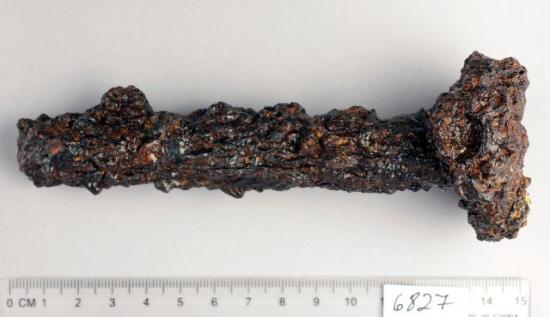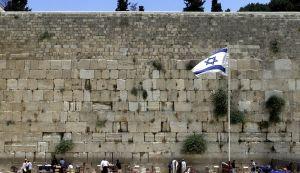Metal tool was discovered at the bottom of the wall, which hadn't been build by Herod at all, other evidence shows
Nir Hasson
Source -http://www.haaretz.com/archaeology/.premium-1.586670

The ancient chisel: Could the stonemason have just not bothered to climb down the scaffolding to retrive it?Photo by Clara Amit, Israel Antiquities Authority
Archaeologists have found a stonemason's chisel that they believe may have been used by the builders of the Western Wall in Jerusalem.
Actually Eli Shukron, an archaeologist working for the Israel Antiquities Authority, found the chisel last summer while digging at the lower base of the Western Wall, south of the Western Wall courtyard. However, the IAA has preferred to remain silent on the discovery, based on the need to study the tool and other evidence further before issuing any statements, it explained.
Shukron has been digging in the area of the City of David and the Western Wall together with Prof. Ronny Reich for the past 19 years, until a few months ago. In recent years Shukron had been excavating inside a tunnel found to lead from the City of David into the Old City, passing beneath its massive stone wall and ending at the Western Wall.

A general view of the Western Wall in Jerusalem, July 4, 2002. Photo by Reuters / Haaretz Archive
The Second Temple had been erected on the site now known as Temple Mount in Jerusalem. The Western Wall was built as a support wall, extending the area so tens of thousands of worshippers could come on pilgrimages at the same time.
In effect the tunnel is part of a drainage system built beneath the main road during the Second Temple period. At its end within the city, the tunnel is right by Temple Mount and the lower area of the Western Wall, which had been a wall of the Second Temple.The chisel is just one of many archaeological treasures that Shukron and Reich reported from the area. Other finds include a Roman sword, cooking vessels from the period of the Great Rebellion, a gold bell that they think may have adorned the robe of the High Priest, and a ceramic seal apparently used to confirm the suitability of sacrifices brought to the Temple.
Herod didn't do it
The excavation also shed much light on the way the Western Wall was built. The most dramatic discovery was a number of coins found beneath the wall, which led to rethink its date of construction – and who was behind it.
Until the coins' discovery, the Western Wall had been thought to be part of King Herod the Great's gargantuan construction drive – which included the Second Temple itself. He is also credited with building the fort at Masada, among his many other architectural achievements.
But Shukron and Reich now say Herod hadn't been responsible for the Western Wall: going by the date of the coins found under it, the Wall had been built after his time, by one of its heirs.
Oh the humanity
And, as said, a metal stonemason's chisel was found in the drainage tunnel last summer. The chisel is 15 centimeters long. Its head had become flattened, almost mushroom-shaped, from being repeatedly banged on rock.
Shukron suspects a builder working at one of the higher levels of the Western Wall, from a scaffolding structure, dropped the thing and couldn't be bothered to climb down and retrieve it. Thus the metal artifact became covered by rubble and stayed that way for 2,000 years. Or maybe he did climb down but couldn't find it.
"I have no doubt that it belongs to the time the Wall was built," Shukron says. "We found it at the base of the Western Wall, about six meters below the main street of Jerusalem in the era of the Second Temple. The coins we found in the area, and ceramics too, indicate that it was at the time the Western Wall was built. The chisel itself was found inside rubble of stone chips that fell from the stonemasons working on the rocks comprising the Western Wall."
It is true that the rocks comprising the Western Wall had been transported there from far away. But the final work on the giant stones, and the job of fitting them with incredible precision, were done on site.
In contrast to the stones at the lower layer of the Wall, which remain quite natural in shape, the stones nearer the top were beautifully worked.
"People pray and kiss these holy stones every day, but somebody carved them, somebody chiseled them, somebody positioned them," Shukron says. "They were workers, human beings, who had tools. Today for the first time we can touch a chisel that belonged to one of them."
The IAA commented that the chisel had been found more than a year ago, and it is awaiting results of tests on the implement, and on other findings at the site. When solid results come in, it will comment, the IAA stated.